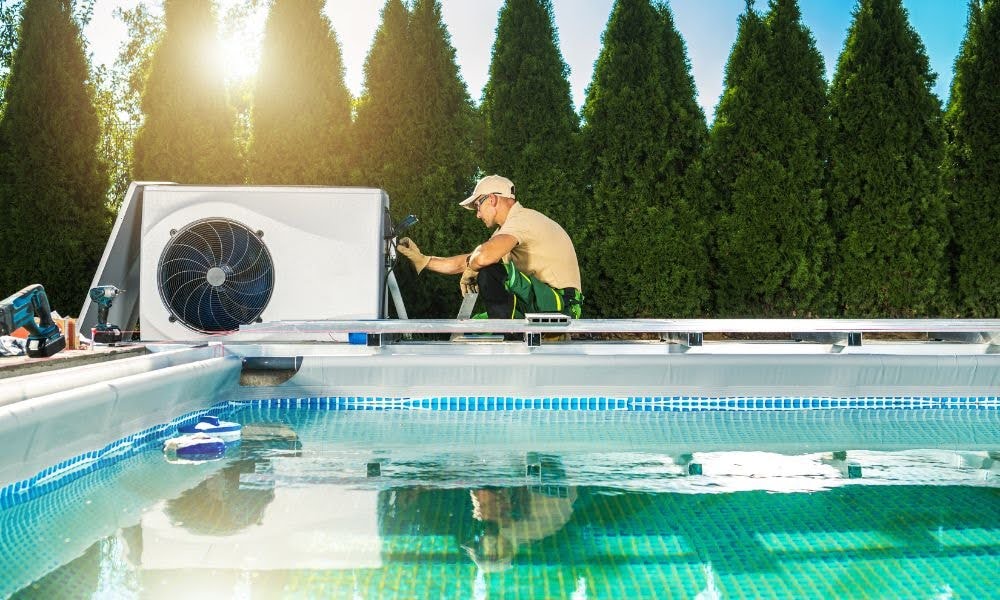Can a Heat Pump Replace a Furnace?
As homeowners look for ways to improve energy efficiency, the question of whether a heat pump can replace a traditional furnace has become more common. Heat pumps are systems that move heat from one place to another, functioning as both a heater and an air conditioner.
On the other hand, furnaces generate heat by burning fuel like gas, oil, or electricity to warm your home. The key difference between the two is that heat pumps transfer heat, while furnaces create it, making each system suitable for different climates and needs.
With growing concerns about energy efficiency and environmental sustainability, more homeowners are considering a heat pump furnace replacement. Heat pumps offer an eco-friendly alternative, as they rely on electricity and have the potential to lower carbon emissions. The rising cost of utilities has made heat pump installation a smart financial move for those seeking long-term savings.
Heat Pumps: How They Work
A heat pump works by transferring heat between your home and the outside environment using a refrigerant, rather than generating heat like traditional systems. In cold weather, it pulls heat from outside to warm your home, and in hot weather, it reverses the process to provide air conditioning. The key components involved are the compressor, condenser, evaporator, and expansion valve, all working together to regulate indoor temperatures efficiently.
Heat pump energy efficiency is a standout feature compared to traditional heating methods, as it can lower energy consumption by relying on heat transfer rather than combustion. This dual-function system makes heat pumps an ideal choice for those seeking both heating and cooling options in one, with reduced utility costs over time.
Types of Heat Pumps
- Air-source heat pumps: Extract heat from the outside air for both heating and cooling.
- Ground-source (geothermal) heat pumps: Use stable underground temperatures for greater efficiency.
- Water-source heat pumps: Draw heat from nearby water sources like lakes or ponds for heating and cooling.
Furnaces: How They Work
A furnace operates by generating heat through the process of combustion heating. In this system, fuel such as natural gas, oil, or electricity, is burned to produce heat, which is then distributed throughout the home via ducts. The key components of a furnace include the burner, heat exchanger, blower, and flue. Each part works together to ensure that warm air is efficiently circulated, providing consistent heating during cold months. Unlike heat pumps, which transfer heat, furnaces create heat directly, making them especially effective in colder climates.
Furnaces can run on different fuel types, with heat pump oil furnaces being a common option in regions where oil is more accessible. Depending on the fuel type used, the efficiency and operation costs can vary. For instance, natural gas is often more cost-effective, while electric furnaces may have higher operating costs but are easier to maintain.
Types of Furnaces
- Natural gas furnaces: Common in urban areas, these are highly efficient and affordable to run.
- Oil furnaces: Typically found in rural areas, they are more expensive to operate but offer strong heating performance.
- Electric furnaces: Easy to install and maintain, though often more costly due to electricity prices.
- Propane furnaces: An alternative for homes without access to natural gas, offering similar efficiency but at a higher fuel cost.
Key Differences Between Heat Pumps and Furnaces
The biggest difference between heat pumps and furnaces is how they heat your home. A furnace creates heat by burning fuel, while a heat pump moves heat from one place to another. This means heat pumps work best in mild climates, while furnaces are more reliable in very cold weather. When it comes to efficiency, heat pumps are usually more efficient, but furnaces can provide stronger heat during freezing conditions.
Another key difference is energy source. Heat pumps run on electricity, making them more eco-friendly, while furnaces rely on fuel like gas or oil. Installing a heat pump is usually more expensive upfront, but they require less frequent maintenance. Furnaces, though more complex and needing more upkeep, typically last longer and work better in colder temperatures.
Efficiency Considerations
When choosing between a heat pump and a furnace, understanding their energy efficiency and performance in cold climates is key. Each system has its strengths depending on the environment and your energy needs.
Energy Efficiency
Heat pumps are more energy-efficient in mild climates because they transfer heat rather than creating it. This efficiency is measured by Seasonal Energy Efficiency Ratio (SEER). Furnaces, which burn fuel to produce heat, are measured by Annual Fuel Utilization Efficiency (AFUE). While heat pumps can lower utility bills due to their higher efficiency, furnaces might still be a good choice in areas where fuel costs are lower.
Performance in Cold Climates
Heat pumps can struggle in freezing temperatures, becoming less efficient when it’s very cold. Furnaces, however, work reliably in cold regions because they generate heat directly. For areas with mixed climates, a hybrid system (a heat pump with a backup furnace) is a great option, offering efficient heating in both mild and cold conditions.
Cost Considerations
Heat pumps usually cost more to install upfront, with prices ranging from $4,000 to $7,000, while furnace installation is often cheaper, typically between $2,500 to $5,500. However, heat pumps run on electricity, which tends to cost less than the fuel (gas, oil, or propane) used by furnaces. Over time, heat pumps can save money on energy bills, especially in mild climates. On the other hand, furnaces may have higher operating costs, and repairs for fuel systems can be more expensive.
Environmental Impact
Heat pumps are better for the environment, as they have lower carbon emissions and can use renewable energy like solar or wind power. Furnaces, by burning fuel, release more greenhouse gasses, which contribute to air pollution. Over time, a heat pump’s carbon footprint is much smaller than that of a furnace, making it the more sustainable choice.
Climate Suitability: Where Each System Works Best
Choosing between a heat pump and a furnace largely depends on the climate you live in. Each system performs better under certain conditions, and understanding where they work best can help you make the right choice for your home.
Heat Pumps in Mild to Moderate Climates
Heat pumps are ideal for areas with mild or moderate winters, where temperatures remain above freezing. They provide efficient heating and cooling, but in extreme cold, their performance declines, requiring more energy or a backup heat source.
Furnaces in Colder Climates
Furnaces are more suitable for colder climates, especially in regions with harsh, sub-zero winters. They consistently produce heat by burning fuel, making them dependable in freezing temperatures without needing any backup system.
Can a Heat Pump Fully Replace a Furnace?
When considering whether to replace your furnace with a heat pump, it’s important to understand how each system fits different climates and energy needs.
When Heat Pumps are a Smart Choice
Heat pumps are highly effective in mild climates where winters aren’t severe. They offer the benefit of providing both heating and cooling in one system, making them efficient year-round. If your home prioritizes energy efficiency and reduces carbon emissions, a heat pump is an ideal solution. It’s also a good choice for regions where electricity is affordable or sourced from renewable energy.
When Furnaces Make More Sense
In cold climates, furnaces stand out for their ability to provide reliable warmth even during harsh, freezing winters. Homes located in regions where natural gas or other fossil fuels are more accessible and cost-effective might find furnaces to be a better heating solution. Their ability to generate direct heat ensures comfort no matter how low the temperature drops.
Hybrid Systems: A Balanced Solution
If you’re looking for flexibility, hybrid systems might be the answer. These systems combine a heat pump with a furnace, using the heat pump for efficiency in milder conditions and switching to the furnace in extreme cold. This combination maximizes energy savings while ensuring reliable heat when it’s needed most.
Advantages of Replacing a Furnace with a Heat Pump
Switching from a furnace to a heat pump can lead to lower energy bills due to the system’s higher efficiency, especially in milder climates where less energy is needed to heat the home. Heat pumps are also environmentally friendly, as they rely on electricity rather than burning fossil fuels, which reduces carbon emissions.
Heat pumps offer comfort flexibility, functioning as both a heating and cooling system in one, which is convenient year-round. Finally, having an energy-efficient system like a heat pump can increase home value, as buyers are increasingly interested in green, cost-saving technologies.
Disadvantages of Replacing a Furnace with a Heat Pump
As mentioned, one of the main drawbacks of heat pumps is their high initial cost. Installing a heat pump system is generally more expensive than installing a furnace, which can be a barrier for some homeowners.
Another concern is their performance in extreme cold; heat pumps can struggle to efficiently heat a home in freezing temperatures, making them less reliable in harsh climates. Because heat pumps rely on electricity, they are dependent on power, meaning a power outage could leave your home without heat unless you have a backup system.
Hybrid Heating Systems: A Balanced Approach
A hybrid heating system combines the best of both worlds by using a heat pump for milder weather and a furnace for colder days. It’s like having two systems in one, automatically switching between them depending on the temperature, so you’re always comfortable without overusing energy.
Benefits of Hybrid Systems
One of the biggest perks of a hybrid system is its year-round efficiency. During mild weather, the heat pump keeps energy use low, and when winter hits hard, the furnace kicks in for reliable warmth. This smart switching helps save on energy costs, making your home both comfortable and budget-friendly.
When to Consider a Hybrid System
A hybrid system could be the perfect fit if you live in an area with mixed climates—warm some days, cold on others. It’s also a great choice if you want to maximize comfort while cutting down on your energy bills. With a hybrid, you get flexibility and peace of mind, no matter what the weather brings.
Technological Advancements in Heat Pumps
Next-generation heat pumps are pushing the boundaries of what these systems can do, with cold-climate heat pumps now designed to perform efficiently even in freezing temperatures. Variable-speed compressors adjust the heating or cooling output based on demand, improving energy efficiency and comfort.
Smart thermostats and system integration with smart home technology allow homeowners to control and optimize their heat pumps remotely, ensuring ideal temperature settings while saving energy. Looking ahead, the continued evolution of heat pump technology promises even greater efficiency, durability, and adaptability, making them a key part of the future of home heating.
Making the Right Choice: Heat Pump vs. Furnace
If you’re weighing whether to stick with your furnace or switch to a heat pump, it really comes down to your climate, budget, and long-term goals. Heat pumps are ideal for homes in mild climates looking for an energy-efficient, environmentally friendly option that can also cool your home in the summer. Furnaces, on the other hand, are better suited for homes in colder regions that need reliable, powerful heat during the winter months.
If you’re torn between the two, consider a hybrid system that combines the efficiency of a heat pump with the reliability of a furnace. This way, you get the best of both worlds—lower energy costs and year-round comfort. No matter what you choose, focusing on energy efficiency and future costs can help you make the best decision for your home.









